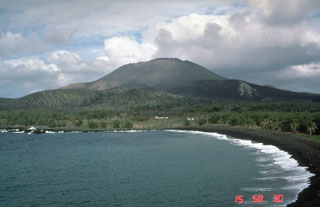Report on Pagan (United States) — 20 April-26 April 2011
Smithsonian Institution / US Geological Survey
Weekly Volcanic Activity Report, 20 April-26 April 2011
Managing Editor: Sally Sennert.
Please cite this report as:
Global Volcanism Program, 2011. Report on Pagan (United States) (Sennert, S, ed.). Weekly Volcanic Activity Report, 20 April-26 April 2011. Smithsonian Institution and US Geological Survey.
Pagan
United States
18.13°N, 145.8°E; summit elev. 570 m
All times are local (unless otherwise noted)
On 23 April, a Northern Mariana Islands status report noted that a NOAA research vessel in the vicinity of Pagan reported night time observations of incandescence at the summit of the volcano. Eruptive activity was considered currently to be at a low level; however with the possibility that the activity may escalate the Aviation Color Code for Pagan was raised to Yellow and the Volcano Alert Level to Advisory. Recent satellite image observations were obscured by clouds.
Geological Summary. Pagan Island, the largest and one of the most active of the Mariana Islands volcanoes, consists of two stratovolcanoes connected by a narrow isthmus. Both North and South Pagan stratovolcanoes were constructed within calderas, 7 and 4 km in diameter, respectively. North Pagan at the NE end of the island rises above the flat floor of the northern caldera, which may have formed less than 1,000 years ago. South Pagan is a stratovolcano with an elongated summit containing four distinct craters. Almost all of the recorded eruptions, which date back to the 17th century, have originated from North Pagan. The largest eruption during historical time took place in 1981 and prompted the evacuation of the sparsely populated island.

